Buddha’s Gems: Chaki and Chanoyu
In Chanoyu, the utensils used to prepare a bowl of tea, are primarily useful, but some have symbolic associations. Sen no Rikyū’s Tea teacher, Take-no Jō-ō, 武野紹鴎, War-field Help-gull, espoused “Cha Zen Ichi Mi ”, which forever united Tea and Zen Buddhism.
Images of the Buddha and other Buddhist deities have on their forehead a mark, gem, jewel, representing the urna, which is a long white hair that is symbolic of Buddha’s wisdom and enlightenment. In Japanese, urna is called byaku-go, 白毫, white-hair. A similar mark also represented by a gem or jewel or coloring on Buddha’s head at the base of a mound of hair on the crown of his head. The mound is called an ushnisha, in Japanese ni-kkei, 肉髻, flesh-topknot, and the gem is called a ni-kkei-shu, 肉髻珠, flesh-topknot jewel. The Sanskrit word ushnisha comes from the root word, uṣ, meaning to burn, consume, as well as meaning turban, theoretically because it keeps the head warm.
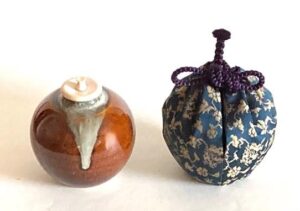
Bun-rin cha-ire, 文琳茶入, literary-gem tea-receptacle, ceramic jar with amber glaze, and ivory lid; Taka-tori-yaki, 高取焼, High-take-fired, by Fuji-saki Ju-zan, 藤崎寿山, Wisteria-cape Longevity-mountain, Fukuoka-ken, 福岡県, Fortune-hill-prefecture. With shi-fuku, 仕覆, serve-cover, silk fabric drawstring bag with pattern of Shu-kō don-su, 珠光緞子, Town-field Gem-bright.
Ma-tcha, 抹茶, powdered-tea, of very high quality to be offered to the guest, is temporarily held in a small ceramic jar called a cha-ire, 茶入, tea-receptacle. To show appreciation for the chaire, it is covered with a drawstring bag, shi-fuku, 仕覆, serve-cover, made of fine fabric and tied with a cord. Chaire from China, called Kara-mono, 唐物, Tang-thing, which are highly revered, are handled with particular care, and the cord of the shifuku is tied into a musubi, 結び, tie.

Tea is presented in a cha-wan, 茶碗, tea-bowl, and there countless styles and variations of size and form. Bowls from Song China are especially admired and are treasured in Japan. Those most preferred are called Ten-moku ja-wan, 天目茶碗, Heaven-eye tea-bowl, which somewhat conical and are placed on a dai, 台, stand. Some Tenmoku jawan are held in a fitted shifuku, and the cord is tied in a special bow called a takara-musubi, 宝結び, treasure-tie. The bow appears to be like the silhouette of the chaire wrapped in a shifuku, which would then identify the chaire, but especially the tea within, to being a treasure, a gem.
When a Tenmoku chawan is not in use, it is stored upside down. When there is a group, they are often stacked one upon the other. The profile of the inverted bowl may be likened to that of the stupa, Sanskrit ‘heap’. The mound of earth that covered the remains of the Buddha is called the sha-ri, 舎利, house-advantage, and the remains are held in a reliquary called a sha-ri-tō, 舎利塔, tower. The stupa is a sharitō.
When the ha-kke bon, 八卦盆, eight-sign tray, is used in preparing Tea, a Tenmoku chawan is displayed on the trigram, ☱, Da, 兌, Exchange, sawa, 沢, swamp, Lake, and West.
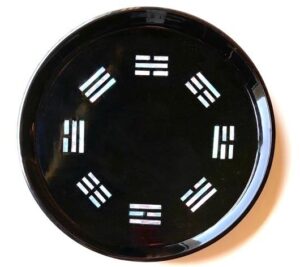
For a very formal and instructive Tea presentation, a Karamono chaire is display in the center of a ha-kke bon, 八卦盆, eight-divination signs tray, of the I Ching, Eki-kyō, 易経, Change-sutra. In preparation for the presentation, the chaire is moved to the trigram, ☳, Shin, 震, Quake, symbolic of kaminari, 雷, thunder and lightning. The trigrams are viewed from the center outward. The trigram for Shin is in the middle of the right side, identified with East and blue/green. The trigram ☲, Ri, Fire / South is at the bottom, the trigram, ☵, Kan, Water is at the top of the tray.
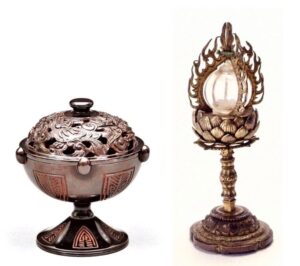
Ho-ya gō-ro futa-oki, 火舎香炉蓋置, fire-house incense-gather lid-rest with pierced lid that is inverted for resting the lid of the kama, 釜, kettle, during a Tea presentation. The pictured hoya has five talons, tsume, 爪, while others have six talons. With five talons there is usually dragon imagery, and one talon is shōmen. Those with six talons, two are shōmen. The dragon, tatsu and ryū, 龍, is a Buddhist symbol of enlightenment.
Although it is based on an incense burner, incense is not burned in the hoya futaoki. If incense were burned in the hoya, it would be the incense burned in the hearth. With the portable fu-ro, 風炉, wind-hearth, byaku-dan, 白檀, white-sandalwood, would be burned, and with the sunken ro, 炉, hearth, neri-kō, 練香, knead-incense, would be burned. The incense may be identified with the shari gems, and seeing and smelling incense smoke emerging from hoya gōro, one might meditate on the Buddha’s entry into Ne-han, 涅槃, Black soil-tub, Nirvana.
The hoya gōro futaoki that is most often used in Chanoyu is modelled on sharitō, which has the primal form of the hō-ju, 宝珠, treasure-jewel. The Kanji for jewel, 珠, includes the Kanji for red, shu, 朱.
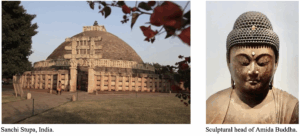
The ushnisha mound on the crown of Buddha’s head resembles the hemispheric portion of the stupa’s mound, called the anda, which covered his remains. Stupa in Japanese is so-tō-ba, 卒塔婆, die-tower-nurse, which was the structure that became the Go-rin-tō, 五輪塔, Five-ring-tower. The great Sanchi Stupa was constructed of red bricks, and later was enlarged using stone. The gem of the ushnisha is usually red – so is it possible that the red gem has some connection with the color and form of the stupa. The ushnisha gem is an attribute only for Buddhas.
The stupa is a sacred monument that enshrines the Buddha’s remains. It symbolizes his enlightened mind and wisdom and serves as a visual and spiritual reminder of the path to enlightenment. Stupas are often visited for meditation and ritual practices. The Great Stupa in Sanchi, India, has a wall that surrounds the mound and has four entrance gates called torana, which means ‘to pass’. Perhaps the gem of the nikkei mound is a kind of entrance to the enlightened mind of the Buddha.
The Sanchi Stupa that has four torana gateways, facing each of the four directions. The Southern gateway is considered the main entrance. The South is symbolically identified with Fire and the color red. The nikkeishu is often depicted with a ruby red jewel. Many Japanese Buddhist temples have nan-mon, 南門, south-gate, which leads to the main structure. The southern quadrant of the heavens is marked with the sign of the Su-zaku, 朱雀, Vermilion-sparrow, which is also identified with Fire.

There are many different types of toranas, such as, patra-torana, with adornments made of leaves, and ratna-torana, made of precious stones. The gemstones may evoke the gemstones on Buddha’s head. Similar adornments may be found in other cultures, such as the Japanese Shintō shime-nawa, which are often hung above entrances for various holidays. The shime-nawa may be hung above the entrance of a Tea house.
The entrance to the ideal yojōhan chashitsu is the small nearly square nijiri-guchi, 躙口, crawl-opening. It is located in the south wall toward the east, which is identified with Asian zodiac sign of Tatsu-Mi, 巽, Dragon-Snake. This Kanji is also read Son, as it is in the Eki-kyō, I Ching, which is identified with Wind. In Chinese, the Kanji also means ‘obedient’, which in is accord with humbling oneself to pass through the nijiri-guchi.
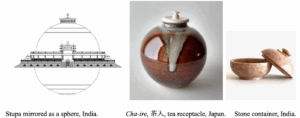
The spherical chaire, identified as a ‘bun-rin’, 文琳, literary-gem, has a dō-himo, 胴紐, body-thread, an incised line around the middle of the jar to indicate that the jar is of two parts; two hemispheres joined together. The ivory lid, zōge buta, 象牙蓋, elephant-tusk lid, is identified with the form of a hei-shi buta, 瓶子蓋, bottle-of lid, sake offering bottle lid. The spherical jar may have its origins in ancient stone cinerary jars in India, like that of the Buddha.

Relic of the Buddha treasured at Niushōshan, Jiangning District of Nanjing City, China. Believed to be the parietal bone from the skull of the Buddha.
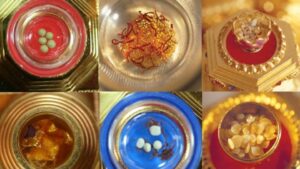
It is essential to know that the remains of the Buddha, as with other revered persons, that during the cremation process, the body, bones, and organs are transformed into ashes and bits of bone. However, there may also be objects that resemble gemstones and pearls, and they are treasures in the remains of the Buddha that were divided into four parts and given to various groups. This is concept is far from fantasy, as the human on its own creates stones out of oddments that enter the body: for example, gallstones, kidney stones, etc. The ashes were also revered, and were divided into eight parts that were dispersed among his followers.
Reliquaries are often put in a prominent place to be seen, revered, and presented with offerings. A cha-ki, 茶器, tea-container, displayed on the ten-ita, 天板, heaven-board, of a stand, such as the tana, 棚, shelf/stand, utilized in Chanoyu.
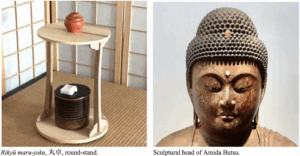
The maru–joku, 丸卓, round-stand, the choice of Rikyū, pictured above, was made of poplar wood by Van Benten copying Rikyū’s stand. Displayed on its ji-ita, 地板, earth-board, is a mizu-sashi, 水指, water-indicate, ceramic cylindrical vessel with black to brown glaze, ‘Seto hitoe guchi’, 瀬戸単口, Rapids-door single-opening, with a black-lacquered nuri-buta, 塗蓋, lacquer-lid. Placed on the lid is a bleached hemp cha-kin, 茶巾, tea-cloth.
On the stand’s upper shelf, ten-ita, 天板, heaven-board, is a shu-nuri, 朱塗, vermilion-lacquered, ya-kki, 薬器, medicine-container. The thin layer of vermilion lacquer has been worn away to reveal the black lacquer base coat; a style called Ne-goro nuri, 根来塗, Root-come lacquer, inspired by the lacquerware utensils at Ne-goro-ji, 根来寺, Root-come-temple, in Wakayama.
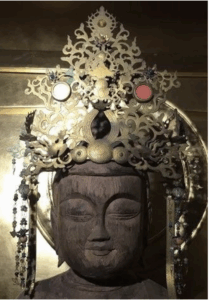
Ancient, wooden image of Kannon with a later, metal adornment with a red disk representing the sun, and a white disk for the moon. Perhaps there is some association between the red and white sun and moon and the Buddha’s red and white gemstones on the head.
The decorative and symbolic metal adornment of the Buddhist image may have been as aspect of the increased involvement with national Buddhism. In 1614, Tokugawa Ieyasu ordered every Japanese family to register at a Buddhist temple, in essence becoming part of the Buddhist sangha, community. This action was to help eliminate Christianity from Japan. There had to be a Buddhist temple in every town, where all rites were to be conducted. The crown adornment was attached to already extant Buddhist images, to reinforce allegiance and belief.
On the forehead of the image of Amida Butsu is a crystal gemstone that represents the urna, byaku-go, 白毫, white-hair, which is symbolic of enlightenment. One may draw a parallel between the white gemstone and the folded cha-kin, 茶巾, tea-cloth, displayed on the mizusashi lid. On the crown of his head is a red gemstone identified with the ushnisha, in Japanese, ni-kkei-shu, 肉髻珠, flesh-topknot-jewel, which is often represented with a ruby-red gemstone. The gem is also symbolic of the intelligence and wisdom of the Buddha. The ushnisha is an attribute solely of Buddhas identified as Tathagata, in Japanese, Nyo-rai, 如来, like-become.

Sculptural cylindrical clear gemstones, often colorless quartz, or various red stones that are embedded into wooden images. Such gems are used on the Buddha’s head as the ni-kkei-shu, 肉髻珠, flesh-topknot-gem.
Japanese words for red include, ake, shu, 朱, red, vermilion, cinnabar, scarlet, red, bloody; beni, kurenai, akai, kō, ke, 紅, crimson, deep red; ake, aka, hi, 緋, scarlet, cardinal red. The Kanji shu, 珠, is composed of ō, 王, jewel (jade), and shu, 朱, red, vermilion. The Kanji, 朱, is part of shu–nuri, 朱塗, vermilion-lacquer, which is found in many objects, including cha-ki, 茶器, tea-receptacle.
In ancient Sanskrit, the ruby is referred to as ratna-raj, jewel-king. The red gem of the nikkeishu combines with the white drop in the byakugo to create the kan-ro, 甘露, sweet-dew, which is the Buddhist elixir of enlightenment. The amrit may be identified with dopamine, or oxytocin, or perhaps excretions from the pineal gland, which is symbolized by the bindu.
In Asian symbolism, a thing is often depicted by an object that is its opposite. The globe of the earth is symbolized by a cube. Formless water is symbolized by a perfectly formed sphere. The color red is associated with Ida, In, 陰, negative, moon, nadi, white is associated with Pingala, Yō, 陽, positive, sun, nadi red. White is symbolized as red, mirroring the red symbolized by the white or clear of red.
When the two streams of ida and pingala nadis are in harmony kundalini rises through the central channel, called Sushumna. It is this movement that allows the red and white drops to combine. Out of enlightenment comes both wisdom and compassion.
The gem on the forehead a little above the eyebrows is the urna in Sanskrit ‘thread’, in Japanese, byaku-gō, 白毫, white-fine hair. It is believed to emit a bright white light that illuminates the universe. It is 31st of the 32 attributes of the Buddha san-jū-ni-sō, 三十二相, three-ten-two-aspect. For some scholars, the byakugō is not the so-called, ‘third eye’.
Buddha’s byakugō, white hair mark is the inspiration for Chinese ‘white tea’, bai-hao, 白茶, white tea. It is also called bai-hao-cha, 白毫茶, white-hair-tea, because the young shoots are densely covered with white hairs. It is also called in Chinese chun-cha, 春茶, spring-tea, haru-cha, for when it is harvested.


Upper image of a gem inlay urna and eyebrows of a gilt-bronze image of Amida Buddha, China.
Below image of an Egyptian symbol of a winged sun, called heru behutet, is identified with Horus, the falcon god, and Ra, the Sun God. The red disk represents the sun and wings of the falcon of Horus. The Horus is Greek for the Egyptian Heru, meaning the ‘distant one’. In Egyptian belief, the sun was born from the right eye of Horus, and the moon from his left eye. In Japan, the creation of the sun is opposite of Egypt’s belief: the sun was born from the left eye of Izanagi, and the moon from his right eye.
The snake motif around the red disk of the sun is part of the maturation of the nervous system called kundalini. The dragon becomes the snake, which in Egypt is part of the headdresses worn by gods, goddesses, and pharaohs. The ancient motif of the winged red sun may evoke in some the Buddhist red byakugo between the eyebrows.
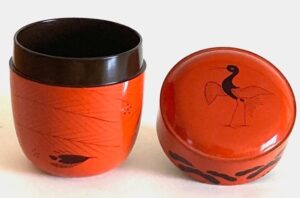
‘Akebono Natsume’, 曙棗, Dawn-jujube, vermilion-lacquered, covered tea container with a design of shõ-chiku-bai, 松竹梅, pine-bamboo-‘plum’, and images of a tsuru, 鶴, crane, on the lid, and a kame, 亀, tortoise, near the base; choice of Gen-gen-sai, 玄々斎, Mystery-mystery-abstain, XI, Iemoto, Urasenke.
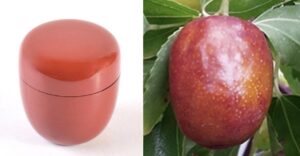
Cha-ki, 茶器, tea-container, in the form of a natsume, 棗, jujube, vermilion-lacquered; H. 1.8 sun kujira-jaku. Ripe natsume, 棗, jujube, Ziziphus jujuba, Chinese date, red date.
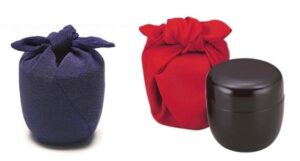
Left: Rikyū-gata chū-natsume, 利休形中棗, Rich-quit-shape middle-jujube, wrapped in an Ō-tsu bukuro, 大津, Great-port bag, natsume wrapped in a red fuku-sa, 帛紗, cloth-gauze; Rikyū chū-natsume.
A Rikyū-gata chū-natsume, 利休形中棗, Rich-quit-shape middle-jujube, can be used to contain koi-cha, 濃茶, thick-tea, to present to guests. It may be wrapped in a purple silk Ō-tsu bukuro, 大津, Great-port bag, created by Rikyū’s second wife So-ōn, 宗恩, Sect-mercy. Also, the natsume may be wrapped in a fuku-sa, 帛紗, cloth-gauze, which may be purple or red silk fabric. This Tea presentation is called ‘Tsutsumi buku-sa’, 包帛紗, Wrap-cloth-gauze. Generally, a purple fukusa is used by men to purify certain Tea utensils, and women use a red fukusa. Purple is an In, receptive color to compliment men’s Yō, positive qualities and red is a Yō color to compliment women’s In qualities. Therefore, the red fukusa wrapper enhances the Yō aspect of the tea container.
For further study, see also: Buddha’s Gem: Chakin in Chanoyu

